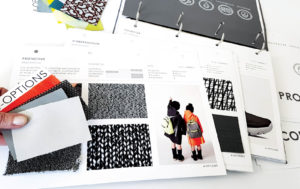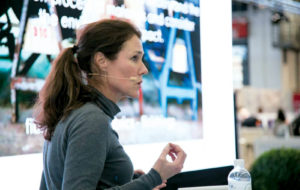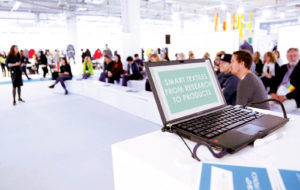
Following her recent podcast Sustainable Textile Sourcing for Performance Textiles in Munich, I caught up with Anne-Marie van Hoof, owner and creative director at 4-Options Studio in The Netherlands, to get her take on what she sees as driving sustainability within the industry now and into the future.
Fiber credentials
The 4-Options Studio offers a bespoke textile sourcing service for designers and manufacturers primarily in Europe and Asia. Advanced and technical textiles feature strongly, but there is also a keen engagement with environmental issues. Van Hoof has noted that designers are becoming more interested in the background of fibers and their environmental credentials in addition to their performance and aesthetics. “In 2050, with a human population of maybe 9.6 billion, we may need three Earth’s worth of resources. To meet the demand, we have to find new ways of making textiles, of making materials,” says van Hoof.
4-Options Studio works with its clients to identify the real impact of textiles on the environment. Van Hoof sees that people are growing with these ideas but that they still need constant reinforcement and a retelling of the story over and over again. Nowadays materials are more central to the design process. For fashion and apparel they started working on paper, then color, and now people are thinking about materials at a much earlier stage, says van Hoof. “Materials are much more in the center, the basis of everything from automotive across all design sectors.”

Apparel is a key client base for the studio and van Hoof has strong views for sustainable trends in the sector. “I think wearable technology was for 10 or 15 years maybe a hype, because people were looking for innovation. If you look at sustainability it is only helpful if it is a solution, a solution for health care, wellness or daily life, but not so much when it is just a fun factor—a dress with lights for instance.”
Van Hoof acknowledges that there are a lot of great ideas coming through, such as Dutch designer Pauline van Dongen’s work with integrated solar cells and lighting for wellbeing and safely. Moving beyond prototypes she sees as still a challenge, doubting that many of the best ideas are scalable at this present time. A trend that 4-Options Studio sees is a move away from smart textiles toward new kinds of yarns as an alternative to polyester, and a focus on new kinds of resources for materials.
New natural fibers

In looking to define a material, an understanding of the production processes and consideration of their environmental impact is essential. The Life Cycle Assessment (LCA) is an objective way to measure the impact of a material from land and raw material use, through energy and water use, emissions, discharge of harmful substances and waste generation—in other words an examination of the complete life of the product from fiber selection to use, reuse and final disposal.
A new generation of natural fibers are emerging that often utilize parts of the plant that would otherwise be discarded. Often, these are only made possible because of technological advances and as such can be termed TechnoNaturals. Van Hoof sees this area as a great potential for sustainable fibers of the future. Natural fibers include Pinatex, made from pineapple leaf with long fibers extracted using a decorticating machine specially developed by the company Ananas Anam founded by Carmen Hijosa a Ph.D. graduate of the Royal College of Art in London. The process is undertaken on the pineapple plantation with leftover biomass used as a natural fertilizer or biofuel. The fibers are degummed and undergo an industrial process to form a nonwoven mesh that is the basis for Pinatex. A special finishing gives it a leather-like quality offering a more sustainable alternative to leather.
As brands and manufacturers are under increasing pressure to be more transparent, this in itself is becoming part of a new business model. Van Hoof is enthusiastic about AlgaeFabrics produced by Studio Tjeerd Veenhoven. In areas that experience excessive algae growth, serious environmental issues can occur—such as worsening water quality. When removed from lakes, algae is often left to decompose or simply burned. The material is made of the Cladophora algae species that is cellulose–rich, accounting for around 70 percent of its content.
Other waste-to-wealth initiatives from the studio include TulipPigments, extracting color from the tulip flower head and PalmLeather, made using arecae betel nut leaves as a leather alternative. Studio Tjeerd Veenhoven is part of a new breed of design studios and undertake the material experimentation, testing, designing and the whole value chain through to proof of principle and sustainable business.
Looking ahead
As our understanding of environmental impacts continue to evolve so does best practice and legislation. Van Hoof does not see that the move toward more sustainable materials and products necessarily comes from the market itself: “You always have some people that are in front of the trend. For instance, you have the Dutch inventor Boyan Slat who started The Ocean Cleanup and you have some brands like G-Star with denim from recycled ocean plastics. It starts with innovators then has a ripple effect that gains momentum with larger companies and brands.”
With a move toward greater automation and reshoring, I asked van Hoof whether she saw an environmental opportunity in such initiatives. According to van Hoof, “I think where the production is more close by the area where you want to sell, it is really a step forward and it will be closer to market. You will see small companies working in different ways. In The Netherlands there used to be a lot of textile manufacturing, now you see more textile companies coming back and setting up. You see this in the food industry as well as with restaurants working with seasonal and local foods.”
As our understanding of environmental impacts grows, the nature and relationships between textile manufacturers, sourcing studios and brands will no doubt continue to evolve as well. 4-Options Studio values being able to work with companies where they can connect technology with creativity, with an emphasis on identifying the real value of product. “I think it is even more interesting to help companies with small steps,” says van Hoof, “we are constantly looking for more sustainable alternatives. These may be small steps for companies but with a big impact as a part of a wider movement. That is really our mission.”
Marie O’Mahony is an industry consultant, author and academic. She the author of several books on advanced and smart textiles published by Thames and Hudson and Visiting Professor at the Royal College of Art (RCA), London.
 TEXTILES.ORG
TEXTILES.ORG


